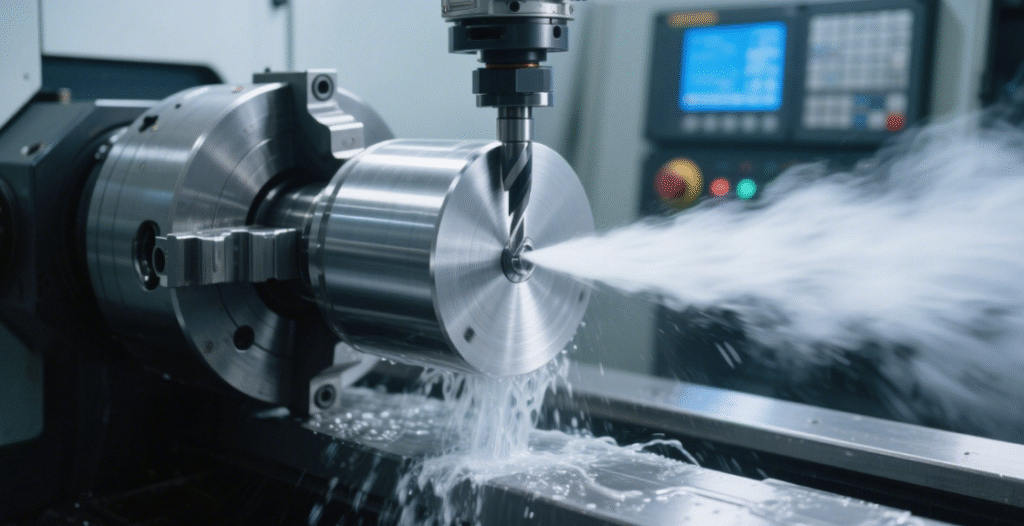Table of Contents
Introduction
In precision manufacturing, achieving the best possible surface finish in metal parts is essential. Turning is one of the most widely used machining processes to ensure smooth and high-quality finishes on a variety of materials, including steel, aluminum, and more. Whether in automotive manufacturing, aerospace components, or even medical devices, the role of turning in improving the surface finish of metal parts cannot be overstated.
At Shandong Qilu Industrial Co., Ltd., we specialize in the production of high-quality tool steels like P20, H13, D2, and S7, all of which are ideal for turning operations. With our expertise in steel processing, we understand the impact that surface finish has on the performance, longevity, and appearance of metal parts. In this blog, we will delve into how turning works, its impact on surface finish, and the benefits it brings to industries relying on precision metalworking.
What is Turning?

Turning is a machining process where a cutting tool removes material from a rotating workpiece to produce a cylindrical shape. The workpiece is held on a spindle and is rotated while a cutting tool is applied to it, removing material until the desired shape, size, and surface finish are achieved. This method is commonly used to manufacture components such as shafts, bushings, and rings.
The ability of turning to create smooth, precise, and consistent surfaces makes it a favored method for applications that require high-quality finishes. When paired with the right tools and techniques, turning can achieve surface finishes that meet strict specifications, leading to superior performance in the final product.
The Role of Turning in Surface Finish Quality
The surface finish of a metal part is not just about aesthetics—it’s a crucial factor in determining the part’s functionality, performance, and longevity. A finely finished surface can enhance the part’s durability, reduce friction, minimize wear, and even improve its visual appeal. Whether in automotive components, aerospace parts, or industrial machinery, the importance of achieving the right surface finish through processes like turning cannot be overstated.
Turning is widely regarded for its ability to produce excellent surface finishes. This machining process helps in the precise removal of material from a rotating workpiece, ensuring smooth surfaces. By employing the right techniques and choosing optimal parameters, manufacturers can achieve superior surface finishes that lead to parts performing at their best. Below are some key ways turning improves surface finish quality:
Precision Movement and Smoothness
During the machining process, the cutting tool interacts with the rotating workpiece in a controlled manner, gradually removing material in thin layers. This precise material removal is essential for achieving a smooth, high-quality finish. The interaction between the tool and the part ensures that imperfections are minimized, and in some cases, additional finishing passes are required to meet the specified finish standards.
Reduced Surface Roughness
One of the primary benefits of this technique is its ability to significantly reduce surface roughness. By controlling the machining parameters—such as feed rate, speed, and depth of cut—operators can fine-tune the process to achieve a smooth surface. Lower surface roughness not only improves the part’s appearance but also enhances its performance. A smoother surface reduces friction, which leads to better wear resistance and improved longevity. Additionally, smoother surfaces are less likely to trap contaminants, contributing to the part’s functionality in its intended application.
Optimal Tooling
Choosing the right cutting tool is a key element of achieving the best surface finish in turning. High-quality tools made from durable materials, such as carbide or high-speed steel, ensure better surface finishes and reduced wear during machining. At Shandong Qilu Industrial, we specialize in providing tool steels like H13, P20, and D2, which are perfect for turning due to their exceptional wear resistance and durability. These tool steels are widely used in producing precision components that require a smooth surface finish, including mold and die manufacturing, where surface finish is critical to the functionality and life cycle of the tool.
Key Factors that Influence Surface Finish in Turning

Achieving a high-quality surface finish in turning involves optimizing several key factors. By adjusting these variables, manufacturers can fine-tune the process and achieve the desired result while improving efficiency and reducing production time.
| Factor | Explanation |
|---|---|
| Cutting Speed | Faster cutting speeds reduce friction, which can improve the surface finish. However, too high of a speed may lead to excessive tool wear. |
| Feed Rate | A lower feed rate generally results in a finer surface finish, but it may also increase machining time. |
| Depth of Cut | Shallow cuts can provide a smoother finish, while deeper cuts may leave more visible marks on the surface. |
| Tool Material | The material of the cutting tool directly affects the surface finish. High-quality tools, like those made of carbide, reduce surface imperfections. |
| Coolant Use | The right coolant reduces heat buildup, which can improve the quality of the surface finish by preventing thermal damage. |
By adjusting these factors to suit the specific needs of a given job, manufacturers can ensure that the turning process achieves optimal surface finishes. Properly optimizing these parameters not only helps produce a superior product but also enhances efficiency and reduces operational costs.
How Turning Improves the Durability of Metal Parts
Beyond just improving the surface appearance, machining plays a significant role in the durability and overall performance of metal parts. The smoother the finish, the more resistant the part is to friction, wear, and potential damage over time.
A smooth surface reduces friction between components, which minimizes the amount of heat generated during operation. This is especially important for parts that undergo regular movement or contact, such as gears, shafts, and bearings. With a finely finished surface, the part becomes more durable and performs better in demanding conditions.
Industries like automotive, aerospace, and heavy machinery rely heavily on surface finish to enhance the performance of components. For instance, parts like gears or aircraft engine components that experience constant friction will last longer when finished using the turning method. The reduced friction not only extends the life of the part but also improves its overall efficiency. Additionally, smoother surfaces reduce the risk of corrosion by minimizing areas where moisture or contaminants can accumulate.
The Impact of Turning on Surface Finish in Different Materials

Not all materials respond the same way to turning operations, and the surface finish achieved can vary depending on the material being worked on. Here’s how turning affects some commonly used materials:
- Steel: This process works exceptionally well with steel, particularly tool steels like P20, H13, and D2. These materials are known for their hardness and wear resistance, which make them ideal for precision applications. Tool steels are frequently used to create molds and dies, where surface quality is paramount. Their durability allows for extended machining times without compromising finish quality. At Shandong Qilu Industrial, we specialize in producing high-performance materials like H13, ideal for demanding tasks that require precise finishes.
- Aluminum: Aluminum, being a relatively soft metal, responds well to machining and can achieve excellent surface finishes. A fine surface on aluminum components can help reduce oxidation and improve their overall appearance. Industries such as aerospace and automotive frequently use aluminum parts with high-quality surface finishes, not only for functional purposes but also for aesthetic reasons. Properly controlled parameters ensure a fine finish that also enhances the material’s corrosion resistance and strength.
- Titanium: Titanium is more challenging to machine due to its hardness and tendency to work-harden. However, turning remains an effective method to achieve a polished finish on titanium parts. The use of carbide tools and proper cutting speeds helps in minimizing tool wear and achieving a fine finish. Turning titanium parts to a smooth finish is especially crucial in applications such as medical devices and aerospace components, where both strength and biocompatibility are important.
- Brass and Copper: These metals are relatively easy to machine and respond well to finishing processes. Components made from brass or copper benefit from smooth, high-quality finishes that improve corrosion resistance. These materials are often used in plumbing, electrical, and decorative applications, where appearance and functionality are essential. Parts made from these metals that are finely finished through machining perform better in high-contact situations due to reduced friction.
Conclusion
In conclusion, turning is a critical machining process that greatly improves the surface finish of metal parts. By controlling factors like cutting speed, feed rate, and tool material, manufacturers can achieve superior surface finishes that enhance the functionality, durability, and appearance of the final product. At Shandong Qilu Industrial Co., Ltd., we specialize in high-quality tool steels like P20, H13, and D2, ideal for turning operations, and our commitment to precision ensures the best results for our clients.
If you’re looking to optimize your manufacturing processes and need high-performance tool steels for turning, contact us today. We offer customized solutions to meet your specific needs, backed by years of experience and innovation.
FAQ
Q1: How does turning improve surface finish?
A: Turning improves surface finish by providing precise control over the material removal process, reducing surface roughness, and achieving a smooth, polished surface.
Q2: What factors influence surface finish in turning?
A: Factors such as cutting speed, feed rate, depth of cut, tool material, and coolant use all play a role in determining the surface finish in turning.
Q3: Can turning be used on all materials?
A: Yes, turning is versatile and can be applied to a wide range of materials including steel, aluminum, titanium, and brass, with varying levels of surface finish quality based on the material.
Q4: How does surface finish affect the durability of metal parts?
A: A smoother surface finish reduces friction and wear, leading to improved durability and performance, particularly in parts that undergo frequent motion or contact.
Q5: How can I get a quote for tool steel for turning?
A: To get a personalized quote for high-quality tool steels suitable for turning, contact Shandong Qilu Industrial Co., Ltd. Our team is ready to provide you with the best solutions for your needs.
For further inquiries or to request a quote, reach out to Shandong Qilu Industrial Co., Ltd. today and take your manufacturing processes to the next level!
✨ Let’s Stay Connected!

If you enjoyed this blog on mechanical parts processing, don’t forget to join me on social media for more insights, updates, and community discussions.
📘 Facebook – Connect with me here
Let’s keep exploring, learning, and growing together. Thanks for reading, and see you in the next post! 🚀

